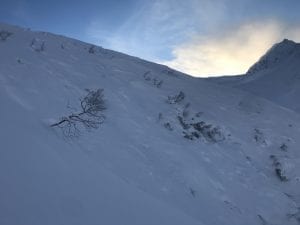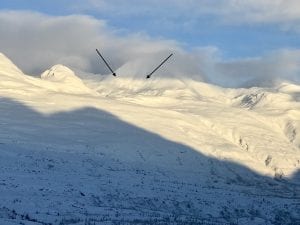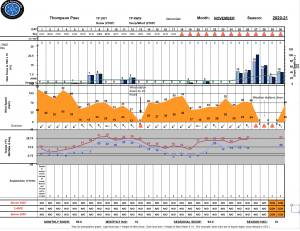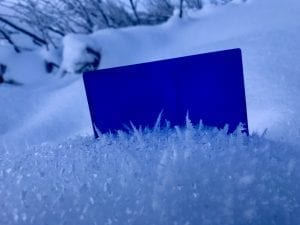Valdez
Above 3,000ftConsiderable
1,500 to 3,000ftConsiderable
Below 1,500ftConsiderable
Degrees of Avalanche Danger
Avalanche Problems
Problem 1
16″ of new snow has been reported at Thompson Pass in the last 48 hours with more on the way. The latest storm began with low density snow. Rising temperatures may cause the snow line to rise up to 1700′ Tuesday night. This will cause the upper portion of the snowpack to become top heavy, and will create widespread areas of unstable snow. Storm snow avalanches up to 3 feet deep will become increasingly likely through the day. Avalanches will have the potential to step down into deeper layers in the snowpack and create very destructive avalanches.
Likelihood:
- Almost Certain
- Very Likely
- Likely
- Possible
- Unlikely
Size:
- Historic
- Very Large
- Large
- Small
Trend
- Increasing
- Steady
- Decreasing
Problem 2
Surface Hoar and near surface facets that formed during the benign weather of 12/8-12/14, are now buried by ~2 feet of snow. As heavy snow continues and temperatures rise this layer may be overcome and create natural avalanches late Tuesday night into Wednesday morning. This layer will likely be reactive to human triggers 12/22 in terrain steeper than 32°.
Likelihood:
- Almost Certain
- Very Likely
- Likely
- Possible
- Unlikely
Size:
- Historic
- Very Large
- Large
- Small
Trend
- Increasing
- Steady
- Decreasing
Problem 3
Southeast winds were strong with gusts to 40 mph recorded on Thompson Pass 12/21. This wind combined with ~9 inches of new snow has built wind slabs on lee aspects that will likely be reactive to human triggers. Wind slabs will become deeper through the day, with continued heavy snowfall and winds increasing tonight.
Likelihood:
- Almost Certain
- Very Likely
- Likely
- Possible
- Unlikely
Size:
- Historic
- Very Large
- Large
- Small
Trend
- Increasing
- Steady
- Decreasing
Avalanche Activity
12/20- A powder cloud reached the highway at the mp 42 slide path. “Three Pigs”. No other details available
-Numerous small (3-4″ deep) natural avalanches were observed in the Python and Cracked Ice Buttress area.

12/20- Multiple D1 soft slabs off Mt Cheddar Cheese Wedge (Hippie Ridge) originating from ~6500′

12/3- Numerous natural avalanches were observed north of Thompson Pass with many avalanches failing at the ground. Observations were not made south of Thompson Pass.
Avalanches observed from 46 mile towards Thompson Pass:
Three Pigs: Nearly every path on the SE face ran with debris deposits stopping in the top 1/3 of aprons, thick alders prevented slides from running full path. These were mostly D3 avalanches.
40.5 Mile Peak: Many paths running similar to Three Pigs, with one running full path to the Tsaina river. Mainly W-NW aspects, D3’s
Max High (Peak on the southern extent of Hippie Ridge) had a D3 avalanche with a crown near 5500′,SW aspect.
Upper Catchers Mitt bowl E aspect, slid R4-D3 ,triggering further avalanches lower down.
The main activity noted, was on the buttresses on the east side of the pass, from Cracked Ice through North Odessey Gully. Every buttress had significant avalanche activity originating ~4000-5000′. Many of these failed at the ground, north – northwest aspect. Pictures below.
School Bus and North Odyssey Gully both ran with debris in the runouts.
Many other large to very large natural avalanches occurred.




12/2- DOT reported a natural D2.5-3 avalanche that hit the Lowe river at Snowslide Gulch.
11/30- Natural avalanche observed on 40.5 mile peak just to the South of the Shovel. West aspect, ~4500′, crown ~200′ wide, poor light prevented further observation. SS-N-R1-D2-U.
11/29: Natural avalanche observed on Billy Mitchell Cry babys shoulder, similar elevation as 11/16 slide but originated a couple hundred meters further west. Released from ~4000′ with a crown length of ~ 200 meters, North aspect, ~ 37°, failed at the ground. HS-N-R2-D2.5-G

11/16: Natural avalanche observed on Billy Mitchell “Cry babys shoulder”. Released from~3500′ with a crown length of ~200 meters, North aspect. This slide was triggered by recent NE wind cross loading the slope. SS-N-R2-D2-U
11/15: Natural avalanche observed in Loveland Basin on a South aspect, down the ridge from Tones Temple. This slide was triggered by recent NE wind loading and failed at the ground. SS-N-R1-D2-G
Weather
12/21- Heavy snow, snow line rising to ~1700′ and strong E-SE wind. Storm totals of 3-4 feet of snow is possible for road level at Thompson pass through Wednesday afternoon.

The Thompson Pass Mountain Forecast covers the mountains (above
1000 ft) surrounding Keystone Canyon through Thompson Pass to
Worthington Glacier.
This forecast is for use in snow safety activities and emergency
management.
Today Tonight
Temp at 1000` 33 F 29 F
Temp at 3000` 28 F 30 F
Chance of precip 100% 100%
Precip amount
(above 1000 FT) 0.66 in 0.44 in
Snow amount
(above 1000 FT) 5-9 in 2-6 in
Snow level sea level sea level
Wind 3000` ridges E 15-35 mph E 15-35 mph
Remarks...Periods of snow with gusty southeasterly winds
expected through Wednesday.
| Date: 12/22 | 24 hr snow (inches) | HN24W (snow water equivalent inches) | High Temp (F) | Low Temp (F) | Weekly SWE Inches (Monday-Sunday) | December snowfall | Season snowfall | HS (snowpack depth inches) |
| Valdez | 14 | .75 | 29 | 19 | .86 | 41 | 84 | 40 |
| Thompson Pass | 9 | .8 | 26 | 18 | 1.5 | 89 | 207 | 54 |
| 46 Mile | Trace | ~ | 36 | 6 | .32 | 32 | 61 | 26 |
Thompson Pass weather history 20/21. Click on links above the images to see full size view


Additional Information
12/19-12/20- Continued stormy weather incrementally deposits ~12 inches of low density snow. Top 3-4 inches doesn’t bond well to underlying snow and is reactive on 12/20 in multiple locations.
12/17-12/18- Significant north winds along with light snow has built wind slabs on lee aspects. These slabs may be sitting on persistent grains such as near surface facets in some locations.
12/13-12/16- Light snow has been falling and has landed on surface hoar below 3000′. This layer exists north and possibly south of Thompson Pass. On Thompson Pass proper, buried surface hoar is unlikely due to wind. So far there is an insignificant amount of snow to overload these layers and create dangerous conditions. This will be a layer to watch below 3000′ once more snow accumulates, possibly by this weekend. If you have observed surface hoar in the Port of Valdez area leave an observation.
12/8-12/12- Clear cold and calm was the theme during this period. With this, surface hoar has begun to form below 3000′. On 12/12 surface hoar was found to exist up to 1.5 cm in length on flat benches. On slopes the size was 2-4 mm. SH has not been observed in high elevation start zones. If conditions remain calm before the next snowfall this will form a sensitive layer in our snowpack in our low and mid elevation bands.


12/5-12/7- Thompson Pass received 23 inches of snow with 2.23″ of SWE. Temperatures and freezing line rose mid storm bringing rain to the coast.
NE winds began 12/4 and have redistributed the storm snow onto lee aspects. This wind event has not been widespread and appears to be concentrated to areas in close proximity to Thompson Pass.
November was mostly dominated by clear, cold and windy weather. On 11/25 a major wx pattern shift occurred which produced 8 days of consecutive storms that delivered 10 inches of water and 90″ of snow to Thompson Pass. This storm fell on a thin snowpack with poor structure near the ground. On 12/1-12/2 a widespread natural avalanche cycle occurred with many avalanches failing at the ground. This event was caused by 4.6″ of SWE on Thompson Pass in a 72 hour period along with rising temperatures bringing the freezing line up to 3000′.
Announcements
The avalanche hazard is Considerable at all elevations. Heavy snowfall, increasing temperatures and strong E-SE winds will all combine to create dangerous avalanche conditions. Human triggered avalanches up to 3 feet deep are likely and natural avalanches are possible. Travel in or below avalanche terrain is not recommended today.
For more information click the (+full forecast) button below.
Your observations are valuable! If you have been out recreating in the mountains, please leave an observation.


